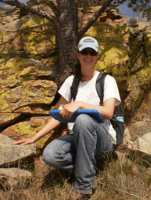Electron Donor Contributions to Denitrification in the Elk Valley Aquifer, ND

Amanda Kreigeris a graduate student pursuing a Master of Science in Environmental Engineering at the University of North Dakota (UND). She graduated cum laude with a Bachelor of Science in Geological Engineering from UND. Her research specialization is in geochemistry and groundwater remediation, particularly electron donor contributions to denitrification in the Elk Valley Aquifer, ND.
Email: Amanda.Krieger.1@my.und.edu
Fellow: Amanda M Krieger
Advisor: Scott F Korom, Assistant Professor, Department of Geology & Geological Engineering, University of North Dakota
Matching Support: University of North Dakota
Degree Progress: M.S. in Environmental Engineering; expected graduation in fall 2013
Electron Donor Contributions to Denitrification in the Elk Valley Aquifer, ND
Nitrate (NO3-) is associated with some of the most important environmental issues of our time because of its widespread use and its mobility in soil. Nitrate is linked to the fate of carbon, and consequently affects our ability to assess carbon cycles. Denitrification, the conversion of nitrate to harmless nitrogen gas, can remove nitrate from groundwater (Seitzinger, et al., 2006). The four general requirements for denitrification are: (1) the presence of N oxides (NO3-, NO2-, NO, and N2O) as terminal electron acceptors, (2) the presence of bacteria possessing the metabolic capacity, (3) suitable electron donors, and (4) anaerobic conditions or restricted O2 ability (Firestone, 1982). Korom (1992) showed that the most important requirement for denitrification in aquifers is the presence of suitable electron donors. The three types of electron donors that contribute to aquifer denitrification are organic carbon, pyrite (FeS2), and ferrous iron minerals (Korom et al., 2012). These electron donors have been shown to be relatively abundant in our region and particularly in aquifer sediments in eastern ND (Schuh et al., 2006; Klapperich, 2008).
Korom et al. (2005) have developed a novel way to isolate aquifer sediments in stainless steel chambers called “in situ mesocosms” (ISMs). To date, there are 13 denitrification ISMs installed in which 21 denitrification tracer tests have been performed. Results of the tracer tests have been dramatic and have provided unparalleled insights into aquifer denitrification rates and the electron donors contributing to the denitrification. Korom et al. (2012) argued that the ISMs provide the best measurements of local aquifer denitrification rates ever measured. Furthermore, the large size of the chambers allows for long-term monitoring of the geochemical evolution of the groundwater during denitrification so that we may gain insights into the electron donors that contributed to the denitrification. The models showed that denitrification by some non-pyrite Fe(II) was essential to explain the evolution of the groundwater quality parameters observed at this site, which was the first time the distribution of electron donors contributing to aquifer denitrification had ever been reported.
The most notable ISM site is the one in the Elk Valley aquifer (EVA) near Larimore in east-central North Dakota. Groundwater denitrification rates measured at this site are among the fastest in the world (Green et al., 2008; Korom et al., 2010). More importantly, at this site six tracer tests have been performed. Eight ISMs have had repeat tracer tests, but the other seven sites have had only two tracer tests performed in each. Studying data from six tests over eight years may provide further insights into not just what electron donors contribute to denitrification, but how the contributions vary among the electron donors from test to test.
The objective of the proposed research is to study the geochemical evolution of the groundwater in the EVA ISM during each of the six denitrification tracer tests to determine the contributions of electron donors to the denitrification. Preliminary work shows that the contributions vary from test to test.
Progress:
The data are available through previous studies of the EVA near Larimore, ND. PHREEQC (Parkhurst and Apello, 1999), a computer program developed by the U.S. Geological Survey for simulating geochemical reactions, has been used to model the changes in groundwater quality during the denitrification tracer tests in the ISMs to provide insights on the contributing electron donors. Cation exchange capacity of the sediments at the EVA has been evaluated.
The amount of nitrate that was lost beyond that explained by dilution of the bromide tracer, which will be attributed to denitrification, will be determined. The amount of denitrification which is explained by the increase of sulfate, which will be attributed to the oxidation of pyrite, which was the only sulfide mineral found by x-ray diffraction in the EVA sediments (Tesfay, 2006), will be evaluated. The ratios of denitrification by organic carbon and ferrous iron will be determined using PHREEQC, along with the saturation indices of the major minerals found in the EVA (Tesfay, 2006).
Significance:
Nitrate is also the most significant threat to surface and subsurface waters, where it is costly to remediate, it elevates trophic levels, and it is related to hypoxic zones throughout the world and the US, notably that in the Gulf of Mexico (e.g., Rabalais et al., 1996). Furthermore, 135 million people in the United States, which includes 99% of its rural population, rely on groundwater as their drinking water source (EPA, 2000). Rural regions in the US are especially susceptible to nitrate contamination of aquifers because of the predominance of agriculture and the associated use of fertilizers. Therefore, it is no surprise that nitrate is the most common groundwater contaminant (Korom, 1992).
This research will be the first to study the variation in the contributions of electron donors in aquifer sediments for such a long period of time, nearly eight years. This will be yet another step in the UND denitrification research group’s progress in predicting aquifer denitrification parameters based on the electron donors present in aquifer sediment. Furthermore, this research will provide insights into which type of electron donor causes the greatest aquifer denitrification rates.
Conference/Seminar Presentations:
Planned submission of an abstract to the Midwest Ground Water Conference in September, 2013.

Scott Korom
Geology & Geological Engineering
UND


